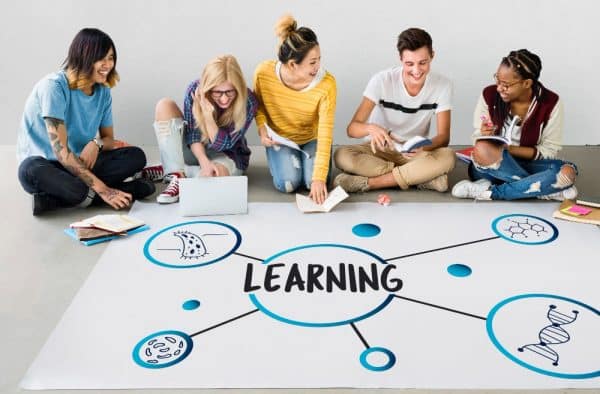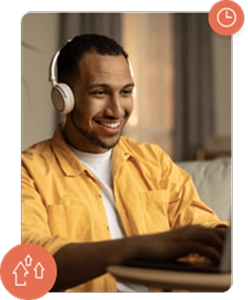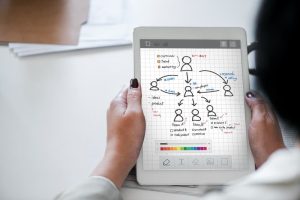
Blended Learning: Definition, Benefits, Examples & More
In today's rapidly evolving educational landscape, blending learning is revolutionizing the way we learn and teach, in particular for training providers. As traditional teaching methods are being complemented and enhanced by innovative approaches, the blended model is gaining significant traction. In this blog post, we delve into blended learning definition, benefits, and examples, as well as provide insights into the essential steps to successfully launch blended programs and courses.

I. What is Blended Learning?
What is the definition of blended learning? Often referred to as “blending learning”, “blend learning”, "blended model”,”blended mode”, or “blended education”, blended learning combines face-to-face classroom interactions with digital learning experiences. In other words, it's a harmonious fusion of traditional teaching methods and modern technology.
In this education style, students engage in both in-person sessions and online activities, creating a dynamic and interactive learning environment. Blended programs offer the flexibility of online education while maintaining the benefits of real-time interaction, resulting in a well-rounded educational experience.
Blended vs Hybrid Learning
You may wonder, what is the difference between blended and hybrid learning. Although "blended" and "hybrid" are terms often used interchangeably in the context of education, they can carry slightly different meanings depending on the context. Generally, both terms refer to instructional models that combine traditional in-person learning with online or digital components. However, the specific implementation and emphasis on each component can vary.
The primary difference lies in the degree of flexibility and the emphasis on options in hybrid learning. Blended learning typically involves a structured mix of in-person and online elements, while hybrid learning often highlights the ability for students to choose between attending in person or participating online on a session-by-session basis. However, because these terms are used inconsistently across different educational contexts, it's important to verify the specific definitions being used by a particular institution or educator.

II. What are the Benefits of Blended Learning? Why Make the Move to Blended Training?
Benefits for Instructors and Educational Institutions
As a training provider, you can leverage blended programs to expand your reach, growing and expanding your training business. Blended learning offers several benefits, including:
- Enhanced Flexibility and Customization: Blended education empowers instructors to tailor their teaching methods to suit the diverse needs and learning styles of students. With a combination of in-person and online components, instructors can create a flexible learning environment that accommodates various paces of learning and individual preferences.
- Increased Cost-Efficiency: By minimizing the necessity for dedicated physical classrooms, blended programs yield cost-effective advantages for educational institutions.
- Data-Driven Insights: Online platforms in blended learning often offer analytics tools that allow instructors to track student progress, engagement levels, and performance on assessments. This data-driven approach enables instructors to identify struggling students early, adapt instructional strategies, and provide targeted support to enhance learning outcomes.
- Efficient Time Management: Instructors can optimize their time allocation by using online resources for certain topics or activities that can be covered outside of class. This frees up valuable in-person class time for interactive discussions, group activities, problem-solving, and addressing specific challenges that students might face.

Benefits for Students
Through blended programs, training providers can not only accommodate diverse student preferences, but also foster a thriving educational community. Blended learning benefits for students include:
- Enhanced Flexibility: Blended learning allows students to balance studies with work, family, and other commitments, providing the flexibility to learn at your own pace.
- Personalized Experience: The combination of online and in-person activities tailors the learning journey to your strengths, preferences, and learning style.
- Active Engagement: Interactive online components such as quizzes and discussions promote engagement and participation, making learning more dynamic and enjoyable.
- Improved Outcomes: Research indicates that the varied approaches in blended education can lead to better understanding, knowledge retention, and application of concepts.
- Community Building: Blended learning fosters interactions with peers and instructors both online and in-person, creating a sense of belonging and a supportive learning environment.
- Optimized Learning Outcomes: Research demonstrates that merging various teaching modalities bolsters comprehension and long-term retention.

III. Blended Learning Types and Examples
In the rapidly evolving landscape of education, innovative approaches to teaching and learning have emerged to cater to diverse student needs and technological advancements. Notably, among these approaches, the blended learning model has gained prominence.
This section will explore different types of blended models, providing examples that showcase the versatility of these approaches in enhancing educational experiences.
The 4 Types of Blended Learning
By combining the benefits of in-person interactions with the flexibility and engagement of online resources, the blended model shapes modern education into a dynamic and student-centred experience. The array of blended learning types demonstrates the adaptability of these approaches across various subjects and contexts. Let’s explore these different educational models in detail.
1. Rotation Model for Blending Learning
In the Rotation Model, students cycle through different stations, each offering a unique learning experience. One station might involve face-to-face teacher-led instruction, while others could encompass online activities, group projects, or independent assignments. This model allows for personalized pacing and diverse learning modalities.
Example: In a science class, students rotate between a hands-on lab station, an online simulation station, and a teacher-led discussion station.
2. Flipped Classroom
The Flipped Classroom model reverses traditional blended education dynamics. Students study digital resources, for example, video lectures and readings, independently outside of class. Therefore, this blending learning type frees up in-person class time. Allowing for interactive discussions, problem-solving, and clarification of doubts.
Example: Before a history class, students watch a pre-recorded lecture at home. Class time is spent analyzing primary sources and engaging in debates about historical events.
3. Flex Model
The Flex Model offers blended learning students greater control over their learning paths and schedules. A range of resources, both online and offline, are available for students to explore at their own pace. Teachers provide support and guidance as students navigate the material.
Example: In a second language course, students access online grammar exercises, vocabulary quizzes, and conversation practice. The teacher then offers one-on-one sessions for focused assistance.
4. Self-Directed Model
In this model, blended education students take the lead in designing their educational journey. Since, they themselves set goals, choose resources, and create projects that align with their interests and strengths. On the other hand, teachers act as mentors, guiding and evaluating the student-led process.
Example: High school students engage in a self-directed research project, selecting topics ranging from environmental sustainability to cultural anthropology. Later, they showcase their findings through multimedia presentations.
IV. Embarking on Your Blended Learning Journey
As explained above, by mixing the best of in-person instruction with the flexibility of online resources, blend programs have the potential to meet the needs of today’s students. But how do you shift from standard teaching methods to blended education?
Starting your venture into blended learning requires deliberate steps tailored to your unique educational approach, including:
- Craft a Blended Strategy: Begin by defining the approach that aligns with your goals. Also, comprehend the synergy of online and in-person education, crucial for an effective blended experience.
- Ensure Technological Equivalence: Guarantee that all your learners possess the necessary technology for seamless engagement. In contrast, if access to devices is limited, consider integrating technology into the physical learning space.
- Empower Students with Tech Skills: Equip your learners with the proficiency to navigate the technology you've chosen. Furthermore, initiate sample lessons for supervised practice in-class or extend guidance for at-home students.
- Experiment with a Singular Approach: To gauge effectiveness, embark on a trial journey with one blended learning method. Recognize the diversity of your students' styles and tech familiarity, and adapt your approach accordingly.
Launching blended courses requires careful navigation, but the results are transformative. By integrating the digital and physical worlds, you're poised to revolutionize learning experiences, enrich engagement, and cater to diverse learner needs.
Your journey begins by envisioning a harmonious fusion of technology and traditional pedagogy – one that sets you on a path to redefine education's landscape.

V. Get Ahead with Timely Training Management Platform
Timely takes the complexity out of creating and launching in-person, virtual, and blended training sessions, all from a unified platform.
Unrestricted by your industry, subject matter, or budget, Timely's Online Training Platform empowers you not only to effectively promote your blended course schedule but also to amplify your audience reach. As you embark on your training program journey, effortlessly managing online registrations becomes a reality with Timely's Training Scheduling Software.
By merging state-of-the-art technology into both training promotion, registration, and management, you position yourself to cultivate an extensive and impactful training ecosystem. This distinctive approach sets you apart within the competitive realm of blended learning.
Ready to embark on this transformative journey? Contact us today to experience firsthand the prowess of Timely Training Management Software. Also, feel free to browse in-depth user guides on our Help Center. Let's shape the future of your blended education endeavours together!
FAQs About Blended Learning
1. What is blending learning?
Blending learning, also known as blended learning, refers to an educational approach that combines traditional in-person classroom instruction with online digital experiences. Further, in this model, students engage in both face-to-face sessions and online activities, creating a dynamic and flexible learning environment. This approach allows educators to tailor their teaching methods, meeting diverse student needs and learning styles.
2. What is the difference between blended and hybrid learning?
Blended and hybrid learning are closely related but not identical. Blended education involves integrating online and in-person elements to create a balanced experience. On the other hand, hybrid learning often emphasizes the flexibility for students to choose between attending in-person sessions and participating online. Nevertheless, while similar, the emphasis and implementation of each approach can vary.
3. When should you use a blended model?
Blended learning is suitable when you want to create a flexible and engaging teaching environment that accommodates diverse student schedules and preferences. Furthermore, it's especially valuable for complex subjects that require both conceptual understanding and practical application. Blended programs are also useful when seeking to reach remote students or provide more cost-effective education options.
4. How does blended learning affect students?
Blended learning positively affects students by offering enhanced flexibility in managing their studies, promoting active engagement through interactive resources, and accommodating various student preferences. Additionally, it empowers students to take ownership of their learning journey and encourages critical thinking. Also, research shows that blending various teaching models improves comprehension, knowledge retention, and application of concepts.
5. Why is blended education effective?
Blended education is effective because it combines the benefits of both traditional and online education. Also, blended programs offer flexibility for students to learn at their own pace while maintaining the value of in-person interactions. Interactive online resources engage students, and the variety of teaching methods enhance comprehension and retention. Finally, the customization of learning experiences and data-driven insights also add to improved outcomes.






